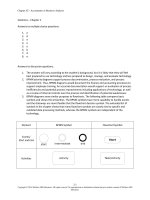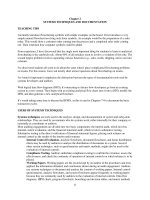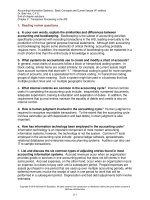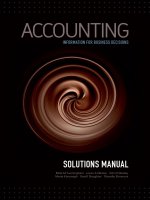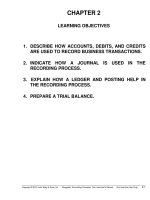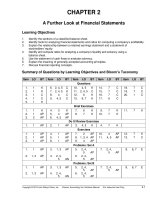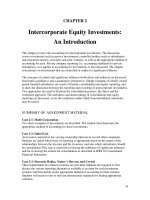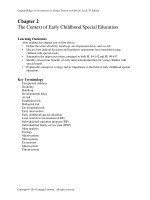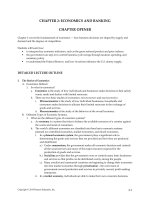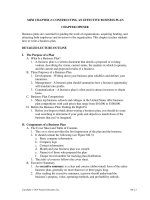Test bank and solution of better business 4e solomon (2)
Bạn đang xem bản rút gọn của tài liệu. Xem và tải ngay bản đầy đủ của tài liệu tại đây (1.07 MB, 36 trang )
MINI CHAPTER 2: CONSTRUCTING AN EFFECTIVE BUSINESS PLAN
CHAPTER OPENER
Business plans are essential for guiding the work of organizations, acquiring funding, and
attracting both employees and investors to the organization. This chapter teaches students
how to write a business plan.
DETAILED LECTURE OUTLINE
I. The Purpose of a Plan
A. What Is a Business Plan?
1. A business plan is a written document that details a proposed or existing
venture, describing the vision, current status, the markets in which it operates,
and the current and projected results of a business.
B. Three Purposes of a Business Plan
1. Development—Writing down your business plan solidifies and defines your
intentions.
2. Management—A business plan should summarize how a business opportunity
will translate into profits.
3. Communication—A business plan is often used to attract investors or obtain
loans.
C. Business Plan Competitions
1. Many top business schools and colleges in the United States offer business
plan competitions with cash prizes that range from $10,000 to $100,000.
D. Before the Business Plan: Finding the Right Fit
1. Before you begin to think about writing a business plan, you should do some
soul searching to determine if your goals and objectives match those of the
business that you’ve imagined.
II. Components of a Business Plan
A. The Cover Sheet and Table of Contents
1. The cover sheet provides the first impression of the plan and the business.
2. It should contain the following (see Figure M2.3):
a. Basic company information
b. Company logo
c. Contact information
d. Month and year business plan was created
e. Name(s) of those who prepared the plan
f. Unique record number for tracking plan distribution.
3. The table of contents follows the cover sheet.
B. Executive Summary
1. An executive summary is a clear and concise (abbreviated) form of the entire
business plan, generally no more than two or three pages long.
2. After reading the executive summary, a person should understand the
business’s purpose, value, operating methods, and profitability outlook.
Copyright © 2016 Pearson Education, Inc.
MC2-1
C. The Company and Management Team
1. This section presents the “big picture” and defines the company and its
purpose. It should include:
a. Mission and vision statements
i. The mission and vision statements should spell out what the founder
ultimately envisions the business to be with respect to growth, values,
and contributions to society.
b. Industry profile
i. The industry profile describes the context in which the business will
operate.
c. Company profile and strategy
i. The company profile provides details regarding how the business
works and why it has a unique chance to impact the industry.
ii. The company strategy summarizes the company’s plans for growth
and profits.
d. Anticipated challenges and planned responses
i. This section discusses potential vulnerabilities from competition,
suppliers, resources, industry, or economic situations.
e. Management team
i. This section should list the members of the management team and the
pertinent experience, knowledge, or creative ability that each member
brings to the team.
D. Market Analysis
1. The market analysis section identifies who your customers are and explains
how you will reach them.
a. The main purpose of this section is to explain the benefits of your product.
2. This section should include an assessment of the general market and:
a. Market research—an analysis of the market to determine whether enough
customers exist and will continue to exist
b. Assessment of the competition
E. The Product
1. Product description
a. This should include any testing you’ve conducted and approvals you’ve
received as well as trademarks, copyrights, or patents.
b. It is also important to discuss ongoing service aspects, such as warranties
and repairs.
2. How product will be produced
3. Pricing strategy
a. Detail aspects that require a higher price.
b. Conduct a thorough analysis of what the competition is charging.
c. List what you expect customers will be willing to pay for your product.
F. Sales and Promotion
1. This section should describe approaches you’ll take to promote the product.
2. It should also describe your selling approach.
G. Financials
Copyright © 2016 Pearson Education, Inc.
MC2-2
1. This section includes financial statements, including the income statement,
balance sheet, and the cash flow statement.
2. You should cover the financial history of the company and have different
forecasts and scenarios projecting the anticipated performance of the business.
3. You should put your financials through a stress test by showing how you
expect the business to perform under worst-case, expected-case, and best-case
scenarios.
H. Appendices
1. Any additional information that adds to the credibility of your business, the
management team, or the industry, such as:
a. Resumes of key managers
b. Pictures of product, facilities, production, and so on
c. Letters of recommendations, professional references
d. Published information
e. Contracts and agreements, copies of patents, copyrights, trademarks
f. Media, articles
NOTE: End the lecture by asking students to write down the muddiest points or main
points of the lecture. This will allow you to know what might need to be reviewed during
the next lecture.
Copyright © 2016 Pearson Education, Inc.
MC2-3
SUPPLEMENTAL ACTIVITIES
Supplemental In-Class/Homework Activity 1
Venture Capitalist PowerPoint Presentation
Activity Overview: This exercise gets students to pare down a business plan into just ten
slides—an “elevator speech” for venture capitalists, if you will.
Time Limit: 20–30 minutes
What to Do:
Tell students that they are being given the opportunity to spend 10 minutes, and only
10 minutes, with a venture capitalist. In that time, they will have to present a sales
pitch for their new business idea. Fortunately, the students will have the equipment
they need to give a PowerPoint presentation, but the presentation can be no longer
than 10 slides, maximum.
Suggest that students construct their presentations as follows:
Slide 1:
Slide 2:
Slide 3:
Slide 4:
Contact information, such as that found on the cover sheet.
Mission statement.
Team members and key background information.
Describe the nature of the problem you address. Try not to get into
how the product solves the problem on this slide. Include how dire a
problem this is and solutions introduced currently by competing
products.
Slide 5: Introduce the product and benefits.
Slide 6: Elaborate on how the product resolves problems introduced on slide 4,
and any relevant technology/methodology used.
Slide 7: Present customer testimonials, product successes, positive media
reactions.
Slide 8: Sales strategy. How do you intend on reaching the customer?
Slide 9: Who are your competitors? What is the market size? How do you think
competitors will react to your product?
Slide 10: Key financial information (may need to slip in a few extra slides to
handle this).
Have students present their final plan to the class for review.
Don’t Forget: Constructing a business plan, even this slide outline, is difficult for many
introductory business students. Giving lots of guidance or doing this together may be
helpful to create a broad understanding of what is required in planning a new business.
Wrap-Up: Have the class critique the business plans as they are presented. Ask them
whether or not they would fund the project, and why. Then ask them to discuss how well
Copyright © 2016 Pearson Education, Inc.
MC2-4
each team incorporated material from the various chapters of the text into their
presentation.
Supplemental In-Class/Homework Activity 2
Business Plan Review
/>Activity Overview: Students locate an actual business plan and critically review it.
Time Limit: 30–45 minutes
What to Do: Students can work alone or in groups. As homework, have students go to:
and look at the business plans that are
presented there. Then, students should assume the role of a venture capitalist. Would they
invest their money in this venture? Why or why not? What areas of the business plan help
promote the business? What areas of the business plan need further refining?
Don’t Forget: Note that although the business plans presented on this website are the
“best of the best”, investors may still not want to finance them, due to economic or other
considerations. Students should be prepared to discuss the rationale behind their
decisions.
Wrap-Up: After providing sufficient time for students to go through the business plan,
come together to discuss student’s findings. What areas of the business plan need
improvement and why? What areas of the business plan were really helpful? Why?
Supplemental Homework Activity 1
SCORE!!
Activity Overview: Students explore the SCORE website.
Time Limit: 5–20 minutes
What to Do: Ask students to visit the SCORE website at www.score.org and write a
brief report on how SCORE can help entrepreneurs and small business owners get
started. Encourage them to click on “About SCORE” and “How Score Can Help You”.
Other places of interest include: “How to” articles and “business templates” and “StartUp Business Plan”, which contains a template for creating a business plan.
Don’t Forget: The idea is to let students know that starting a business is within reach.
Wrap-Up: Anyone who is interested in starting a business can get help from SCORE.
There are many Small Business Association offices located near most people. Help can
Copyright © 2016 Pearson Education, Inc.
MC2-5
also be found from local colleges and universities, if they have a small business
development center, and from local Chambers of Commerce.
Copyright © 2016 Pearson Education, Inc.
MC2-6
ENHANCING THE ONLINE COURSE
SBA Review: Have your students access the information at the website for the Small
Business Administration at www.sba.gov. Ask your students to provide an outline on the
discussion board of the major points of information required/recommended by the SBA
for a business plan.
Business Plan Rally: Have your students search the Internet for at least three examples of
business plans published online by companies (large, well-known companies, if
possible). Ask your students to “audit” the business plans by comparing them to the
example in the mini chapter. Do these plans have the comprehensive information outlined
in the text? What is missing?
On a Mission: Ask your students to identify examples of mission statements of three
Fortune 500 companies as posted online. Ask your students to comment on what is
unique about the mission statements. Are your students surprised at the overall direction
of these companies as stated in the mission statements? Are the stated goals (via the
mission statements) commensurate with the public images of the companies? Have your
students post their assessments on the discussion board.
To Market: Have your students examine the business plans of at least three companies as
posted online. Ask your students to review the market analyses of the business plans. Do
your students think the companies have done a good job in assessing the markets? Are
the online postings lacking in detail? Is it possible that the companies have posted shorter
versions of the analyses? Do the analyses seem to be comprehensive, with usable data
that can be relied on to make decisions?
Financial Review: Using the same companies that the students have previously identified,
have your students review the financial data included in the business plan. Ask them to
audit the financial data to determine: 1) the investment the company will need for startup
or to continue business; 2) outside sources for the investment; 3) outstanding
expenditures or investments (such as capital projects) that are included in the business
plan; 4) timeframe in which return on investment is predicted.
Copyright © 2016 Pearson Education, Inc.
MC2-7
THE BUSINESS PLAN PROJECT: Instructor Notes
Assigning the Business Plan: An Overview
The business plan project is a great learning experience for students. Many students will
enter your classroom with the dream of owning their own business. This project is often
the starting point for making that dream come true. As a result, this project will have a
high level of authenticity for these students. The project also serves as an exceptional
assessment tool, helping you identify how well students have mastered the course
material. More importantly, the business plan project stimulates higher-level thinking that
a learner can take into any profession. During this assignment, students will consider the
many aspects of the world of business and demonstrate an ability to “connect the dots.”
Assigning Part 1: Introduction
Assignment Overview
The first section of the business plan requires that the student generate an idea for a new
business. Students will usually fall into one of two categories. The first are those students
who may never have thought about starting their own business, and may be terrified at
the prospect of creating this type of comprehensive document. These students often need
the most help in generating an idea for their starting point. For students who need a
helpful nudge, you may wish to suggest starting a business that the student finds familiar.
This could be a business in which they are currently employed, for example. The
familiarity will lessen their anxiety about the project, and makes the first step a positive
one. The second type of student is the learner who already has a dream of owning a
business. This project is especially rewarding for these students, but they still may be
concerned about completing a document of this size and therefore may also appreciate
some intermittent guidance.
Files to Provide Students
Because this is the first part of the business plan, provide students with a copy of the
Business Plan Student FAQs. It is located in this chapter of the Instructor’s Manual (see
following pages) as well as on www.mybizlab.com. Give students ample explanation of
the project, your expectations for how it should be completed, and due dates.
For this part of the project, students will be asked to complete Part 1: Introduction of
the Business Plan Project Appendix.
Estimated At-Home Completion Time
Completion time will vary based on what students bring to the class. Students who
already have a business idea will have a head start on those who do not. During the early
stages of the project, it’s a good idea to devote adequate classroom time for feedback.
Copyright © 2016 Pearson Education, Inc.
MC2-8
Homework Assignment Deliverable from Students
Each business plan is a unique document, so some variance in response length is
expected. For example, a student who demonstrates higher-level thinking may write 20 to
25 pages during this project, whereas other students may produce 10 to 15 pages. The
length will also be affected by the business chosen. As a result, you may wish to
designate a range of pages for this assignment rather than a set minimum length. For Part
1, expect a range of 1 to 3 pages.
Assigning Part 2: The Company and Management Team
Assignment Overview
This section is quite comprehensive and features several challenging tasks that require
students to examine internal and external aspects of a business. The first task involves
creating a mission statement, which includes establishing the business’s position with
respect to ethics and social responsibility. Next, the student is asked to describe the
industry and sector in which the company operates and to outline potential opportunities
and threats presented by external factors such as macroeconomic matters, technological
changes, legislation, and the like. This is often quite challenging for many students
because it requires them to think with a broader viewpoint. Be prepared to offer feedback
and encouragement. Then, looking internally, students are asked to define the company
profile and business strategy by establishing goals and then evaluating the company’s
strengths and weaknesses. Lastly, the student describes the key players in the
organization and creates an organizational chart.
Files to Provide Students
For this part of the project, students will be asked to complete Part 2: The Company
and Management Team of the Business Plan Project Appendix.
Estimated At-Home Completion Time
If done thoughtfully, this part of the plan will require a minimum of 4 to 6 hours to
complete. Students may struggle with completing the industry analysis, especially
identifying the external threats and opportunities. You may wish to use class time during
each section to respond to questions.
Homework Assignment Deliverable from Students
The length of student response in this section will again vary depending on the
complexity and size of the proposed business. For Part 2, expect a range of 4 to 6 pages.
Copyright © 2016 Pearson Education, Inc.
MC2-9
Assigning Part 3: Marketing
Assignment Overview
This part of the project asks students to create a marketing plan, identifying their target
market and their competitors, discussing their product, and explaining how they will
attempt to attract the target market. Because they use their creativity, students often enjoy
completing this part of the business plan.
Files to Provide Students
For this part of the project, students will be asked to complete Part 3: Marketing of the
Business Plan Project Appendix.
Estimated At-Home Completion Time
A well-constructed explanation of the Marketing section will require 3 to 5 hours.
Instructor feedback will improve the quality of responses so you may wish to use class
time during each section.
Homework Assignment Deliverable from Students
The length of student response will range from 4 to 6 pages, but could be as many as 8 to
10 pages.
Assigning Part 4: The Financials
Assignment Overview
In this section, students will begin to determine if their business is truly viable. The
student’s responses to questions about the costs of doing business will be used as a
starting point for the financial reports. Remind students that all of their submitted values
are estimates, and there is no sure-fire method for accurately measuring how a business
may perform. Many students will have trouble estimating their costs. Some assistance is
shown on the student template, and you may want to create a class list of resources that
students would find helpful.
The business plan provides Excel templates for students to use in this section. These
Excel spreadsheet templates include built-in formulas so that calculations are
automatic based on student input—the student only has to “drop in” his or her
numbers. The Excel templates are located on www.mybizlab.com. If your students
cannot access these Excel documents, there are free templates available through
SCORE’s website at www.score.org/template_gallery.html.
The section concludes by asking students to evaluate all of the costs that are necessary to
get the business off the ground. Once students are aware of those costs, they must
determine how to get funding for their business.
Copyright © 2016 Pearson Education, Inc.
MC2-10
Files to Provide Students
For this part of the project, students will be asked to complete Part 4: The Financials of
the Business Plan Project Appendix.
Estimated At-Home Completion Time
A well-constructed explanation of this section will require a minimum of 4 to 6 hours.
Instructor feedback is absolutely critical in this section, as most students will need some
direction in gathering information that will help answer the questions related to costs.
Homework Assignment Deliverable from Students
Expect some uniformity of response length in this area, because students will be filling in
their templates. Most students will complete 4 to 5 pages within this section, including
the templates.
Assigning Part 5: The Finishing Touches
Assignment Overview
In this final section, students create an executive summary, summarizing the key aspects
of the entire plan, which they then insert in the front of the plan. Encourage students to be
concise, as an investor would look at the executive summary before reading the details of
the plan. Finally, the student is expected to create a table of contents and cover sheet for
the business plan.
Files to Provide Students
For this part of the project, students will be asked to complete Part 5: The Finishing
Touches of the Business Plan Project Appendix.
Estimated At-Home Completion Time
Although this section asks students to restate what they have already thought through and
written, it can be the most difficult part of the business plan to do right. Most students can
complete this section in 1 to 3 hours, depending on their writing skills.
Homework Assignment Deliverable from Students
Expect some uniformity, as most of the work will take the form of a 1- to 2-page
executive summary and 1 page each for the cover sheet and table of contents. Encourage
brevity in the summary, but emphasize that this is what you’ll be reading first—and it
must capture your attention to entice you to read further.
Copyright © 2016 Pearson Education, Inc.
MC2-11
Business Plan Project Sample Syllabus
Overview
The business plan project is divided into parts that roughly coordinate with the parts and
chapters in the text. Therefore, you can assign the project in parts after students complete
each section of the book. Alternatively, you may wish to assign this project as a capstone
project at the end of the semester. Although the project is designed to be completed
individually, you might also consider grouping students together to provide additional
support and to exchange ideas as they complete their projects. If this project is being
assigned in an online course, it might be best to have one discussion forum dedicated to
students’ questions for this project, so that everyone can ask and respond to one another’s
questions.
Part 1: Introduction
This part of the business plan asks students to come up with an idea for their business,
creating an identity and forming a concrete notion of what the business will do as well as
to identify what makes their product or service unique. The first part of the plan also asks
students to identify the type of ownership the business will take and briefly describe who
the firm’s ideal customers are.
Assign this part of the business plan after completing Chapters 1 through 6.
Suggested 12-week quarter due date:
Suggested 16-week semester due date:
End of week four
End of week six
Part 2: The Company and Management Team
This part of the plan first asks students to create a mission statement and look at how the
business will interact with the community and demonstrate social responsibility. Students
are also asked to think about goals of their business, to describe the industry in which the
business will operate, and determine some internal and external factors affecting the
business. Finally, students will examine the organizational structure of the business. As
part of the assignment, students will also create an organizational chart to show the
framework of the business.
Assign this part of the business plan after completing Chapters 7 through 11.
Suggested 12-week quarter due date:
Suggested 16-week semester due date:
End of week seven
End of week nine
Part 3: Marketing
This part of the business plan asks students to think about marketing’s “Four Ps”—
product, price, place (distribution), and promotion—and how they apply to their
business. Students will list features and benefits as well as the points of difference for
their product or service. After describing the product, students must connect those
described features and benefits to a targeted buyer. Once the targeted buyer has been
named, students will describe advertising and promotional efforts to get the buyer’s
attention.
Copyright © 2016 Pearson Education, Inc.
MC2-12
Assign this part of the business plan after completing Chapters 12 through 14.
Suggested 12-week quarter due date:
Suggested 16-week semester due date:
End of week ten
End of week eleven
Part 4: The Financials
This part of the business plan asks students to think about their business in terms of
financial needs and costs. Students are asked to decide how much of their product they
expect to sell and to identify the costs of doing business. Students will complete a balance
sheet and income statement for their businesses.
NOTE: To keep things simple, we have addressed only fees associated
with broadband access. (There is a line in the P&L sheet for
telephone/Internet expense.) Depending on the business the student is
planning, they can put in website development and maintenance in the
“other” category or add a separate line, if necessary.
Finally, students will need to identify how much funding they will need to start up their
business and to identify source(s) of that funding.
Assign this part of the business plan after completing Chapters 15 and 16.
Suggested 12-week quarter due date:
Suggested 16-week semester due date:
End of week eleven
End of week thirteen
Part 5: The Finishing Touches
This part of the business plan asks students to create an executive summary, table of
contents, and cover sheet for their plan.
Assign this part of the business plan approximately one week before the due date.
Suggested 12-week quarter due date:
Suggested 16-week semester due date:
Copyright © 2016 Pearson Education, Inc.
End of week twelve
End of week fifteen
MC2-13
Student FAQs for the Business Plan Project
1. Where do I begin?
This project will challenge you to think about all of the parts that are necessary for a
business to succeed. You should start by thinking of a business that you would like to
begin. Do not use a product that already exists, such as Coca-Cola, but rather choose a
business that is fairly simple in concept such as an ice cream shop or a bookstore. It
would be best if you also choose a business that is of interest to you. Learning comes
through the process of using your own ideas. Each section of the business plan connects
with the information that is discussed in class and in the textbook.
2. What should my business plan look like?
First, you will need the Business Plan Project Appendix found at the back of the book
or online at www.mybizlab.com. Answer the questions in the order that they are shown.
Note that the project includes hints that will help you answer each question.
Note that the business plan project is also fully explained in the Student Instructions
(see following pages).
You may also use the Sample Business Plan as a guide (see following pages). Note that
your plan does not have to look exactly like the sample, but you need to show good
organizational skills.
3. What do I do with my assignment?
Your instructor will give you instructions as to how he or she would like you to submit
the plan. You will most likely be given a chance to make improvements to your plan
throughout the grading period.
4. How will I know if I’m doing the plan correctly?
Your instructor will provide feedback to you about your plan. Students who successfully
complete the plan have these two qualities in common:
They do not procrastinate. A well-written business plan cannot be written
overnight, as they require a good deal of thought and creativity.
They ask a lot of questions. If a term is used in the business plan template that
confuses you, check in your textbook or ask your instructor for an explanation.
Copyright © 2016 Pearson Education, Inc.
MC2-14
The Business Plan Project: Student Instructions
Completing Part 1: Introduction
In Chapter 5 and in the Business Plan Mini Chapter, we discuss how the starting point for
virtually every new business is a business plan. Business plans describe the business
strategy for any new business and explain how that strategy will be implemented. One
important benefit of a business plan is that in the act of preparing it, would-be
entrepreneurs must develop their business idea on paper and firm up their thinking about
how to launch and run their business before investing precious time and money. In this
exercise, you’ll get started on creating your own business plan by completing Part 1 of
the Business Plan.
Exercise Background: Part 1 of the Business Plan
Before you even begin your business plan, you need to have a “great idea” for a business.
This might be a business that you’ve already considered setting up or something you
decide on now. What are some businesses that you come into contact with on a regular
basis? Restaurants, childcare services, and specialty retail stores are just a few examples
to consider. You may also wish to create a business connected to a talent or interest you
have, such as cooking or car repair. It’s important that for the purposes of the plan, you
create a company from “scratch” rather than using a company that already exists. You’ll
learn more if you use your own ideas.
Once you have your business idea, your next step is to create an “identity” for your
business. This includes determining a business name and an idea of what your business
will do. It also includes identifying the type of ownership your business will take, topics
we discuss in Chapters 5 and 6. The first part of the business plan also briefly looks at
who your ideal customers are.
After you have completed Part 1, take a quick look through the rest of the business plan
project to get a feel for the type of information you will need as you complete the plan.
Your Assignment
Step 1
To complete this assignment, go to the Business Plan Project Appendix in the back of
your textbook or online at www.mybizlab.com. For this assignment, you will answer the
questions in Part 1 of the plan.
Step 2
Once you have the Business Plan Project Appendix, answer the questions in Part 1.
Introduction. Note: Include the question heading for each answer, so your business plan
looks more professional. See the Sample Business Plan for examples. Once you have
answered the questions, be sure to save your Word document—you’ll be adding your
answers from each following part to the same Word document to create your final
Business Plan.
Copyright © 2016 Pearson Education, Inc.
MC2-15
Completing Part 2: The Company and Management Team
In Part 1 of the Business Plan project, you formulated the story of your business. Part 2 of
the Business Plan project asks you to think about goals of your business, some internal
and external factors affecting the business, as well as the organizational structure of the
business.
Exercise Background: Part 2 of the Business Plan
As you learned in Chapter 7, every business sets goals (accomplishments that it hopes
and plans to achieve) and objectives—the short-term targets that are designed to achieve
these goals. Businesses then make decisions about what actions will help them to achieve
these goals. In effect, goals and objectives are the means by which businesses measure
their success or failure. In this part of the plan, you’ll define some of the goals for your
business. But first, you’ll be asked to articulate your company’s mission statement. A
mission statement spells out what you ultimately envision your business to be with
respect to growth and sometimes includes a snapshot of your strategy to achieve such
growth. In addition, a mission statement reflects the overall values of the company and its
owners, and the company’s intended contributions to society.
Part 2 of the Business Plan also asks you to analyze the internal and external factors that
affect your business. These external and internal factors are the fundamental parts of a
traditional SWOT analysis. As you’ll recall from Chapter 7, a SWOT analysis looks at
the business’s strengths, weaknesses, opportunities, and threats.
To begin, you will analyze the industry in which your company will operate, and
articulate the external opportunities and threats that face your company. The
opportunities and threats are generally external factors that affect the business:
Sociocultural forces
Economic forces
Technological forces
Competitive forces
Political-legal forces
Will changes in population or culture help your business?
Will changes in the economy help your business, or hurt it?
Will changes in technology help your business, or hurt it?
Does your business face much competition, or very little?
Will changes in laws help your business, or hurt it?
A positive change in one of these forces is considered an opportunity. A change that hurts
the business is considered a threat. Each of these forces will affect different businesses in
different ways, and some of these may not apply to your business at all. In some
situations, an opportunity for one business may be a threat for another.
You will also be asked to look internally, and identify the strengths and weaknesses of
your business, including global, quality, and technology issues. The strengths and
weaknesses are internal factors—things that the business can control. What does the
business do well (what are its strengths)? What may the business NOT do so well (what
are its potential weaknesses)?
Additionally, you will be asked to outline any challenges you anticipate encountering as
well as the ways in which you plan to respond to those challenges. It is important to have
a plan in place for those unwanted, but sometimes unavoidable, situations.
Part 2 of the plan also asks you to determine how the business is to be run. Part of this
will require you to briefly describe your managers and what contribution they will bring
Copyright © 2016 Pearson Education, Inc.
MC2-16
to the organization. In addition, you will create an organizational chart to get you
thinking about the different tasks needed for a successful business. You’ll also examine
various factors relating to operating your business.
Your Assignment
Step 1
Open the saved Business Plan file you began working on in Part 1. You will continue to
work from the same file you started working on in Part 1.
Step 2
For the purposes of this assignment, you will answer the questions in Part 2: The
Company and Management Team. Note: Once you have answered the questions, be
sure to save your Word document. You’ll be answering additional questions in the next
part.
Completing Part 3: Marketing
So far, your business has an identity, you’ve described the factors that will affect your
business, and you’ve examined your management team and how it will be organized. Part
3 of the Business Plan project asks you to consider your marketing plan.
Exercise Background: Part 3 of the Business Plan
In Part 1, you briefly described what your business will do and who your ideal customer
would be. In this part of the plan, you’ll describe your ideal buyer, or target market, in
more detail, listing their income level, educational level, lifestyle, age, and so forth.
You’ll also describe your main competitors and your plans to respond to their market
presence.
In addition, this part of the plan asks you to describe more fully the product you are
planning to sell. Once you create a clear picture of the product, you’ll describe how it will
stand out in the marketplace—that is, how it will differentiate itself. This part of the
project also asks you to discuss the price of your product.
Finally, you’ll examine how your business will get the attention and interest of the buyer
through its promotional mix—advertising, personal selling, sales promotions, and
publicity and public relations.
This part of the business plan encourages you to be creative. Have fun! Provide as many
details as you possibly can, as this reflects an understanding of your product and buyer.
Marketing is all about finding a need and filling it. Does your product do this?
Your Assignment
Step 1
Open the Business Plan file you began working on in Parts 1 and 2.
Copyright © 2016 Pearson Education, Inc.
MC2-17
Step 2
For the purposes of this assignment, you will answer the questions in Part 3: Market
Analysis. Note: Once you have answered the questions, be sure to save your Word
document. You’ll be answering additional questions in the next part.
Completing Part 4: The Financials
Now that you’ve had fun with your marketing ideas, it’s time to think about the financial
needs of your business.
Exercise Background: Part 4 of the Business Plan
This part of the business plan asks you to consider the costs of doing business, such as
salaries, rent, and utilities. You’ll also complete the following financial statements:
The Balance Sheet: The balance sheet is a foundation for financial reporting.
This report identifies the valued items of the business (its assets) as well as the
debts that it owes (its liabilities). This information gives the owner and potential
investors a “snapshot” into the health of the business.
The Income Statement: This is the focus of the financial plan. This document
will show you what it takes to be profitable and successful as a business owner for
your first year.
After you have identified the costs of doing business, as well as how much revenue that
you expect to earn in one year, you will articulate how much you will need to get the
business started, what kind of funding you will be seeking, and how you will use the
funds.
Your Assignment
Step 1
Open the Business Plan file you began working on in Parts 1–3.
Step 2
For the purposes of this assignment, you will answer the questions in Part 4: The
Financials. Note: Once you have answered the questions, be sure to save your Word
document. You’ll be answering additional questions in the next part.
Completing Part 5: The Finishing Touches
It’s now time to add some finishing touches to your plan.
Exercise Background: Part 5 of the Business Plan
Before you turn in your plan, you need to create a cover sheet and table of contents for
your plan. You’ll then conclude the project by creating an executive summary. The
purpose of the executive summary is to give the reader a quick snapshot into your
Copyright © 2016 Pearson Education, Inc.
MC2-18
proposed business. If written well, it will encourage the reader to continue to read the rest
of the business plan. Although this exercise comes at the end of the project, once you’re
done writing it, you’ll place the cover sheet, table of contents, and executive summary at
the beginning of your completed business plan.
Your Assignment
Step 1
Open the Business Plan file you began working on in Parts 1–4.
Step 2
For the purposes of this assignment, you will answer the questions in Part 5: The
Finishing Touches.
Copyright © 2016 Pearson Education, Inc.
MC2-19
Sample Business Plan
By Roger Miller
Prepared September 2012
The Vault Grill
135 High Street Mainland, PA 12345
Steven Samulson, Owner
234 First Street, Bellview, PA 12498
610-484-2323
Roger Miller, Owner
7901 Deerfield Blvd. Hillside, PA 12234
610-293-1234
Joe Mesland, Owner
24 Oak Ave, Lakeside, PA 12377
610-555-1239
Copyright © 2016 Pearson Education, Inc.
MC2-20
Table of Contents
Executive Summary .........................................................................................................................3
Part I: Introduction ...........................................................................................................................4
Part 2: The Company and Management...........................................................................................5
The Mission Statement .............................................................................................................5
Industry Profile .........................................................................................................................5
Company Profile and Strategy..................................................................................................6
Anticipated Challenges and Planned Responses ......................................................................7
The Management Team ............................................................................................................7
Part 3: Marketing .............................................................................................................................9
Market Analysis........................................................................................................................9
The Product or Service .............................................................................................................9
Sales and Promotion ...............................................................................................................10
Part 4: The Financials ....................................................................................................................11
Copyright © 2016 Pearson Education, Inc.
MC2-21
Executive Summary
The Vault Grill will be located in the town of Mainland, Pennsylvania, a city of
approximately 20,000 people. The restaurant will offer a friendly casual dining
atmosphere for people of all ages. We will serve a large variety of meals and desserts, but
our specialty will be our grilled of fish, steaks, and burgers.
The mission of The Vault Grill is to provide a quality product at a quality price
served by quality people. We will demonstrate our devotion to the community
through customer service and community relations.
Our ideal customers are those who are looking for a fun and casual place to have a great
and affordable meal. We will be located in the downtown area, in a renovated bank
building, so we plan to cater to business men and women during the lunch hour and in the
after-work hours. Additionally, because there is a small college nearby, we also expect
many of our customers will be students and faculty members.
Customers will visit us for several reasons. First are our grilled entrees. They will be the
main appeal for their flavor because Joe Mesland, the grill master, has several special
rubs and sauces that offer a unique flavor to any meat or fish entree. Customers can select
how they would like their entrée prepared by selecting a dry rub or sauce of varying
spiciness. Second, we offer a fun and casual atmosphere that encourages people to relax
and enjoy their time spent at the restaurant.
The Vault Grill is also part of the local history. It is located toward the end of town in the
former National Bank building. The original bank offers a unique atmosphere with
vaulted ceilings, marble floors, and unique windows in the upper areas. We are planning
on keeping the original vault and some of the other fittings to preserve the historical
nature of the building.
Our business will be a limited liability company. We have structured the business as a
LLC for personal protection because we will also be serving liquor.
All partners are well qualified to run this restaurant. Steven Samulson has a degree in
Hospitality Management. He has managed several successful restaurants, including
Henry’s Meat House and The Funky Kitchen. Roger Miller has a degree in business
management, and in addition to a strong background in financial management, was
recently a partner in a local steak house franchise. Joe Mesland, our grill master, was the
head chef at the Cajun Grill for the last ten years and won the prestigious 2007 Silver
Spoon award.
Our business will thrive for a number of reasons. First, the city of Mainland has a
stable population, with a number of healthy industries and a neighboring college.
Second, the local population is upstream middle class. We believe that this segment
of the population will have the desire and income to eat out on a regular basis.
Our skills and knowledge in food service, combined with our connections to the
community, will make this business a sound investment.
Copyright © 2016 Pearson Education, Inc.
MC2-22
PART 1. INTRODUCTION
BUSINESS NAME
The Vault Grill
DESCRIPTION OF BUSINESS
The Vault Grill will be located in the town of Mainland. The restaurant will offer a
friendly casual dining atmosphere for people of all ages. We will serve a large variety of
great meals and desserts, but our specialty will be our grilled of fish, steaks, and burgers.
FORM OF BUSINESS OWNERSHIP
The business will be a limited liability corporation with three primary partners. Each
partner has special skills that they bring to the business.
IDEAL CUSTOMER
Our ideal customers are those who are looking for a fun and casual place to have a great
and affordable meal. We plan to cater to business men and women during the lunch hour
and in the after-work hours as well as to the students and faculty of the nearby college.
We will have special promotions focused on each of these two groups that will be
discussed later.
COMPANY ADVANTAGES
Our grilled entrees will define our customer’s experience and persuade them to choose
The Vault Grill over the other restaurant choices in the area. The main appeal of the
grilled entrees is the flavor, because Joe Mesland, the grill master, has several special
rubs and sauces that offer a unique taste to any meat or fish entrée. Customers can select
how they would like their entrée prepared by selecting a dry rub or sauce of varying
spiciness. Second, we offer a fun and casual atmosphere that encourages people to relax
and enjoy their time spent at the restaurant.
The Vault Grill is also part of the local history. It is located toward the end of town in the
former National Bank building. The original bank offers a unique atmosphere with
vaulted ceilings, marble floors, and unique windows in the upper areas. We are planning
to make the original vault a visible part of the decoration and will be restructuring the
original teller area as the bar. Finally, we will preserve as many of the other fittings as
possible to maintain the historical nature of the building.
Copyright © 2016 Pearson Education, Inc.
MC2-23
PART 2. THE COMPANY AND MANAGEMENT TEAM
THE MISSION STATEMENT
MISSION STATEMENT
Our company aims:
to sell delicious and remarkable food and drinks that meet the highest standards of
quality, freshness, and seasonality and that combine both modern-creative and
traditional grilled styles of cooking,
to consistently provide our customers with impeccable service by demonstrating
warmth, graciousness, efficiency, knowledge, professionalism, and integrity in
our work,
to have every customer who comes through our doors leave impressed by The
Vault Grill and excited to come back again,
to create and maintain a restaurant that is comprehensive and exceptional in its
attention to every detail of operation,
to provide all who work with us a friendly, cooperative, and rewarding
environment, which encourages long-term, satisfying employment, and
to be a giving member of the Mainland community and to use our restaurant to
improve the quality of life in the area.
ETHICAL ISSUES
Our integrity means more than profit; service, quality, and sanitation mean more than
volume; and honesty is the basis of sales and service. Therefore, our code of ethics is
as follows.
We will:
ensure that our food and drink meet the highest standards of quality and freshness
before and after they are prepared,
ensure our pricing and performance are done with honesty and integrity,
ensure our business practices meet the highest standards of service, quality, and
sanitation, and
ensure our employees are treated fairly at all times.
SOCIAL RESPONSIBILITY
The Vault Grill, as an integral part of the Mainland community, will donate any
edible and unused foods to the local food bank and will donate meals to needy
families throughout the year, especially at holidays. We recognize that our
responsibility to society goes beyond food; therefore, we will also have a strong
environmental policy and recycle whatever we can, and sponsor events to promote
healthy lifestyles.
Copyright © 2016 Pearson Education, Inc.
MC2-24
INDUSTRY PROFILE
INDUSTRY DESCRIPTION
The Restaurant sector is in the Services industry. There are many types of restaurants
fighting for the same potential customer base. Fast food giants, smaller take-out
places, to more sophisticated high-end restaurants are all part of the Restaurant sector.
Additionally, cafes, tearooms, and restaurants with ethnic themes such as Italian,
Mexican, Chinese, and Thai are all potential threats to our customer base. The Vault
Grill sees itself positioned in the middle—offering quality meals in a sit-down
environment at an affordable price. There are very few restaurants in the local region
that fall into this type of category.
OPPORTUNITIES AND THREATS
Mainland is a vibrant community that has attracted a variety of businesses, and is also
the home of Newburg College. Although a declining economy may deter some
individuals from spending money eating out, because The Vault Grill charges
reasonable prices and caters to businesses, the potential negative impact of a bad
economy is reduced. The opportunity exists to expand our current customer base
beyond the business and college crowd in Mainland.
In addition to economic strains, other possible threats include severe weather in areas
that supply the produce, which could affect the availability or price of produce.
Similarly, an issue affecting the quality or availability of meat, fish, or poultry (such
as mad-cow disease and mercury in fish) is another possible threat. Non-smoking
restrictions have been put in place for all restaurants in the county. Because this
restriction has been made prior to our opening, we do not believe this will have any
impact on our business.
COMPANY PROFILE AND STRATEGY
BUSINESS GOALS
First-year business goals:
1. To break even
2. To build a strong customer base
3. To minimize employee turnover
Intermediate to long-term business goals:
1. To begin a carry-out and catering service within three years
2. To earn net profits of $500,000 within five years
COMPANY STRENGTHS
Foremost, we have a highly motivated management team with expertise in the
restaurant business from a management and business perspective. In addition, the
chef is an award-winning specialist who has been responsible for grilled food
preparation for over 15 years. Our business is community-oriented and intends to
ensure that we meet the dining and entertainment needs of our customers.
Copyright © 2016 Pearson Education, Inc.
MC2-25
